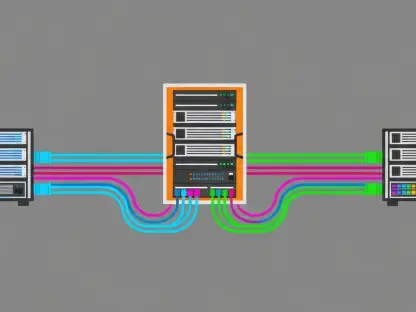In an era where digital transformation dictates the pace of business, the sheer volume of data generated by modern applications has become a formidable challenge for organizations striving to maintain a competitive edge. Global e-commerce platforms, real-time analytics tools, and AI-driven services demand systems that are not just robust but also infinitely adaptable to handle exponential growth in data sources and user expectations. The pressure to deliver always-on, high-speed applications has exposed the limitations of traditional data management practices, pushing companies to rethink their strategies. As data becomes the lifeblood of innovation, the need to modernize how it is stored, integrated, and activated is no longer optional but a critical imperative. This discussion dives into the evolving landscape of data management, exploring how cutting-edge approaches are reshaping the foundation of scalable applications and enabling businesses to thrive in a data-centric world.
Addressing the Data Chaos Challenge
The complexity of managing data in today’s environment cannot be overstated, with medium to large organizations often juggling over 275 distinct data sources, creating a phenomenon aptly described as “data chaos.” This overwhelming diversity stems from disparate systems, cloud platforms, and third-party integrations, all contributing to fragmented data landscapes that hinder efficiency. Traditional methods, reliant on manual processes and outdated replication techniques, struggle to keep pace with the speed and scale required by modern applications. The result is delayed decision-making, increased operational risks, and missed opportunities in leveraging data for competitive advantage. Addressing this chaos requires a fundamental shift toward centralized platforms that can unify data from multiple origins, transforming it into a cohesive, actionable resource for applications and workflows. Such a shift promises not only to streamline operations but also to empower organizations to harness the full potential of their data assets in real time.
Beyond centralization, the focus must turn to enriching and governing data to ensure it meets the stringent demands of scalability and security. Modern applications, especially those driven by AI and analytics, require data that is not only accessible but also reliable and compliant with regulatory standards. This involves transforming raw data into formats that are both usable and protected, ready for activation across various business functions. Innovative technologies are stepping in to bridge this gap by automating integration processes and embedding governance frameworks directly into data pipelines. These advancements minimize human error and ensure consistency, allowing businesses to maintain trust in their data while scaling operations globally. By prioritizing quality and structure at every stage, organizations can build a robust foundation that supports the dynamic needs of today’s digital ecosystem, paving the way for sustained growth and adaptability in an ever-evolving market.
Innovating with Automation and AI
A pivotal element in modernizing data management lies in the adoption of automation and AI-driven solutions that redefine how data is handled at scale. Legacy systems, often bogged down by manual interventions, are being replaced by intelligent platforms capable of automating data delivery for critical processes like DevOps and test data management (TDM). These platforms enhance flexibility by enabling rapid, compliant access to data across teams and applications, significantly reducing the time spent on routine tasks. The integration of AI further amplifies this efficiency by identifying gaps in traditional approaches, such as inefficiencies in data testing or integration bottlenecks. As a result, organizations can accelerate development cycles and improve application performance without compromising on security or compliance, ensuring they remain agile in a fast-paced digital landscape.
Equally important is the role of AI in driving predictive insights and optimizing data workflows for future scalability. By leveraging machine learning algorithms, businesses can anticipate data demands, streamline resource allocation, and proactively address potential disruptions before they impact operations. This forward-thinking approach complements automation by embedding intelligence into every layer of data management, from ingestion to activation. Additionally, AI-powered tools facilitate seamless integration across hybrid and multi-cloud environments, ensuring data remains accessible and actionable regardless of where it resides. Such innovation not only addresses current challenges but also prepares organizations for emerging trends, such as the growing reliance on real-time analytics and personalized user experiences. Embracing these technologies marks a significant departure from outdated methodologies, positioning companies to meet the high expectations of speed and reliability that define modern application ecosystems.
Strategic Planning for Seamless Modernization
Effective modernization of data management demands meticulous planning to minimize disruptions and maximize outcomes during the transition to scalable systems. A structured approach begins with a thorough pre-migration analysis, assessing data quality, identifying duplicates, and mapping dependencies to ensure nothing is overlooked. This preparation is crucial for maintaining operational continuity, especially for businesses reliant on always-on applications like global e-commerce platforms. Solutions that offer out-of-the-box tools for master data management (MDM) and governance play a vital role in simplifying this process, providing frameworks to maintain data integrity throughout the migration. By prioritizing these steps, organizations can avoid costly setbacks and ensure their data infrastructure aligns with the demands of modern applications, setting the stage for long-term success.
Furthermore, strategic modernization extends beyond technical execution to encompass a holistic focus on compliance and efficiency. Ensuring that data meets regulatory requirements during and after migration is non-negotiable, particularly in industries with stringent privacy laws. Advanced tools that integrate AI-driven processes can accelerate this journey by automating repetitive tasks and enhancing data quality at every touchpoint. This not only reduces the risk of errors but also frees up valuable resources for innovation and growth. A well-executed modernization plan balances immediate needs with future goals, allowing businesses to scale seamlessly while maintaining trust in their data systems. The emphasis on governance and structured transitions highlights the importance of a proactive mindset, ensuring that scalability is not just achieved but sustained over time in a rapidly changing technological landscape.
Building a Future-Ready Data Ecosystem
Reflecting on the strides made in data management, it becomes evident that the industry has undergone a transformative shift, moving away from rigid, outdated systems toward dynamic, technology-driven solutions. The challenges of data chaos have been tackled head-on with centralized platforms that unify fragmented sources, while automation and AI redefine efficiency and compliance in handling vast datasets. Strategic planning emerged as a cornerstone, ensuring seamless transitions with minimal disruption to critical operations. Looking ahead, the focus should shift to building resilient, future-ready ecosystems that anticipate evolving demands. Organizations are encouraged to invest in continuous innovation, integrating emerging technologies to stay ahead of scalability challenges. By fostering adaptability and prioritizing data quality, businesses can solidify their position in a digital landscape that rewards agility and foresight, ensuring they are well-equipped for whatever comes next.









